This post may contain affiliate links, my full disclosure can be read here. As an Amazon Associate I earn from qualifying purchases.
If you’ve been growing potatoes for a while you’ve probably encountered the Colorado potato beetle.
They are the most common potato pest and a real nuisance to gardeners and farmers. But the good news is there are easy ways to control potato beetles naturally in your garden.
Yes, these methods really work!
We used to have a terrible problem with potato beetles but after a few seasons of being very diligent about keeping up with hand picking, we completely eradicated them from our gardens and haven’t seen them in years.

Identification
Adults
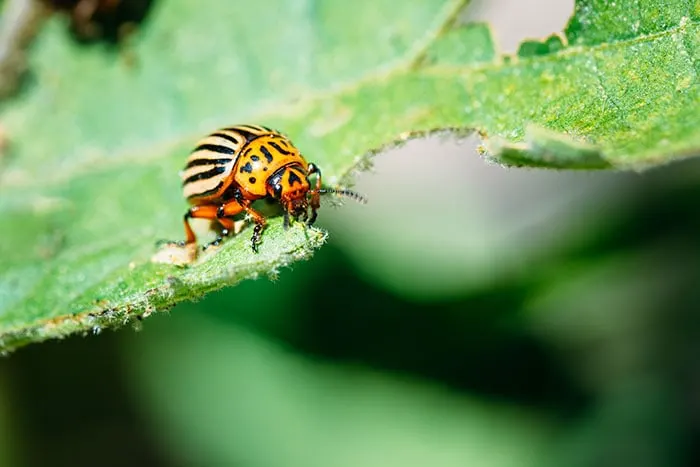
Adult potato beetles are a hard-shelled beetle with a round shape. Their forewings are yellow with 10 black stripes running vertically.
The heads and thorax are reddish in color, with black spots on the head. They grow to be about 1/3 an inch long.
Eggs
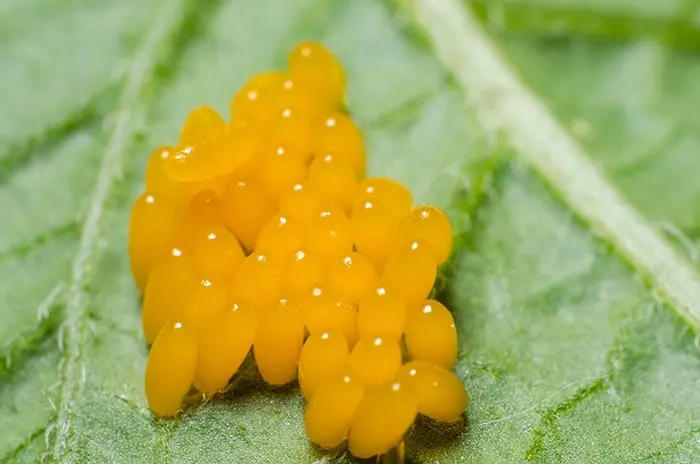
Potato beetle eggs are yellow to bright orange in color and oval-shaped. They are laid in clusters on the undersides of leaves often in groups of 30 eggs.
Larva
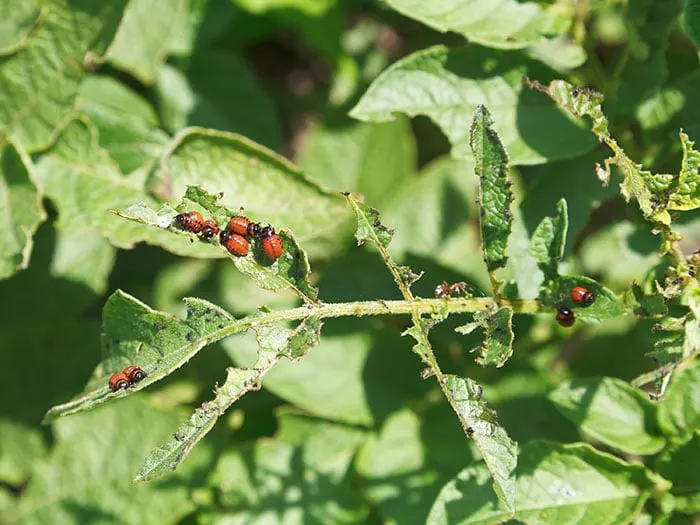
Potato beetle larva starts out brick read later turning pink or orange in color with a black head and legs. They have 2 rows of black spots along each side.
Life Cycle
Adult Colorado potato beetles overwinter below the surface of the soil close to where the host plants have been grown. Then the following spring they emerge in late April to mid-May.
The adult beetles don’t migrate but can fly for several miles to find food.
After breeding the females begin to lay eggs on the underside of leaves on the host plants. This egg-laying stage can last up to a month and each female will lay up to 500 eggs on a potato plant.
Depending on the temperature eggs will hatch in 4 to 15 days.
The larva is easily recognized because of its brick red color and humped back appearance. As they feed on the plants they go through 4 growth stages (instars).
The first to third instar stages last 2 to 3 days each and the larva grows quickly. When they reach the 4th instar stage they stop feeding for 7 days and start to turn a lighter color.
The larva then drops to the soil and burrow 7 inches down and begin to pupate into their adult form.
5 to 10 days later the adult Colorado potato beetle will emerge from the soil and start the cycle over again.
However later in the season, they may simply overwinter until the following spring.
Colorado Potato Beetle Damage
Both the adult and larva of the Colorado potato beetle feed on the leaves of the plants. However, it’s the larva that does the most damage.
Their feeding often starts on the outside edges of the leaves and they can quickly eat an entire leaf just living the veins and stem behind.
It doesn’t take long for them to defoliate an entire potato crop.
If you are wondering what do Colorado potatoes beetles eat it’s not just potatoes. Often we think of Colorado potato beetles as only a potato plant pest but they will feed off any plants in the Solanaceae family (nightshade family).
This includes:
How To Get Rid Of Colorado Potato Beetles

After seeing all the damage in your garden and thinking “How do you control Colorado potato beetles naturally?” because you really don’t want to put toxic chemicals all over your garden the good news is there are lots of ways!
1. Hand Picking
For small to medium-sized gardens handpicking is a great way to control potato bugs. This is how we completely eradicated the Colorado potato beetle from our gardens over time.
If handpicking I recommend wearing a good pair of garden gloves as they contain a chemical that can irritate your skin.
There are 2 ways of controlling potato bugs by hand.
The first is to take a container of soapy water and go through your potato plants picking them off and dropping them into the container.
The second way is to simply squish the bugs by hand (with gloves) or fold the potato leaves over the larva and squish them.
This method has to be done often to keep up with newly hatched potato bugs.
2. BTK
BTK (Bacillus Thuringiensis) is a natural bacteria found in soil that is highly toxic to caterpillars. It works great as a natural way of controlling Colorado potato beetle larva but will have no effect on the adults.
Start spraying the potato plants ever week after they first start growing. As any eggs hatch and the larva starts to eat the leaves the BTK will kill them.
It’s important to realize that BTK takes a few days to work as it affects the digestion tract of caterpillars so you may still see them on your plants for a while after they hatch.
3. Will Neem Oil Kill Potato Bugs?
Yes, neem oil can kill potato bugs but it should be used with care because it can also harm beneficial insects.
Try spraying it later in the evening and make sure to also get the underside of the leaves were potato bugs often hide.
The larva will be killed quickly after spraying with neem oil but adult beetles can take a while.
I don’t find this as effective as the handpicking or BTK method.
4. Will Dish Soap Kill Potato Bugs?
Using a simple homemade spray of dish soap and water is a very easy way to kill many garden pests including potato beetles.
Mix 1 to 2 tablespoons of dish soap with 1 gallon of water and spray it onto the beetles and larva.
The key to making this work is that you have to hit the bugs directly with the soap mixture. Just spraying the leaves won’t work.
5. Diatomaceous Earth
Diatomaceous earth is a powder made from ground-up fossilized diatoms (sea algae) that turned into sedimentary rock. It’s very effective for getting rid of both adult and larva potato beetles.
Insects find the particles of the diatomaceous earth very sharp and will avoid going on plants that contain it or die as it cuts into the exoskeleton of the beetle.
Make sure to use food grade diatomaceous earth like this one as many types sold for gardens contain extra chemicals that act as insect attractants.
6. Floating Row Covers
Floating row covers or bug netting can be an easy way of keeping pests off your potato plants as well.
For row covers to work it’s important to not plant your potatoes in the same area you did last year.
Remember that Colorado potato beetles overwinter in the soil. If you plant and cover in the same place you could have a big break out under the cover and not realize it.
For newly planted areas covering will prevent beetles from flying in from other areas to eat your plants.
Controlling Potato Beetles Is Possible
Colorado potato beetles can be a real nuisance in your garden. But don’t give up! There are many simple methods of controlling them in your garden to save your potato crop.
Start by handpicking the mature beetles and larva, crush the egg clusters as you see them.
Then use an organic spray if needed to get rid of them on your plants.
Do you have a tip for controlling Colorado potato beetles naturally? Leave a comment below to help other gardeners!
Find more help for insect pests here:
- How To Get Rid Of Tent Caterpillars
- How To Control Fall Webworms
- Get Rid Of Squash Bugs
- Control And Get Rid Of Cucumber Beetles
- Repel Mosquitoes Naturally With These Easy To Grow plants
Connect With Homestead Acres!
Be sure to follow me on social media, so you never miss a post!
Facebook | Twitter | Pinterest | Twitter
Visit my Amazon store to find all my favorite gardening, homesteading tools, and gadgets plus all of my printed garden books and journals!

Kim Mills is a homeschooling mom of 6 and lives on an urban homestead in Ontario, Canada. Blogging at Homestead Acres she enjoys sharing tips to help you save money, grow and preserve your own food.

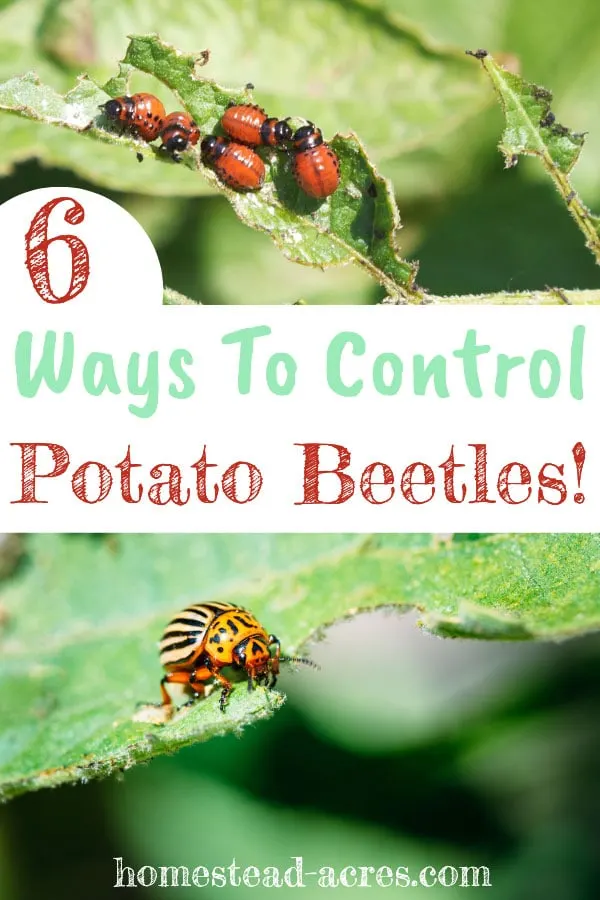
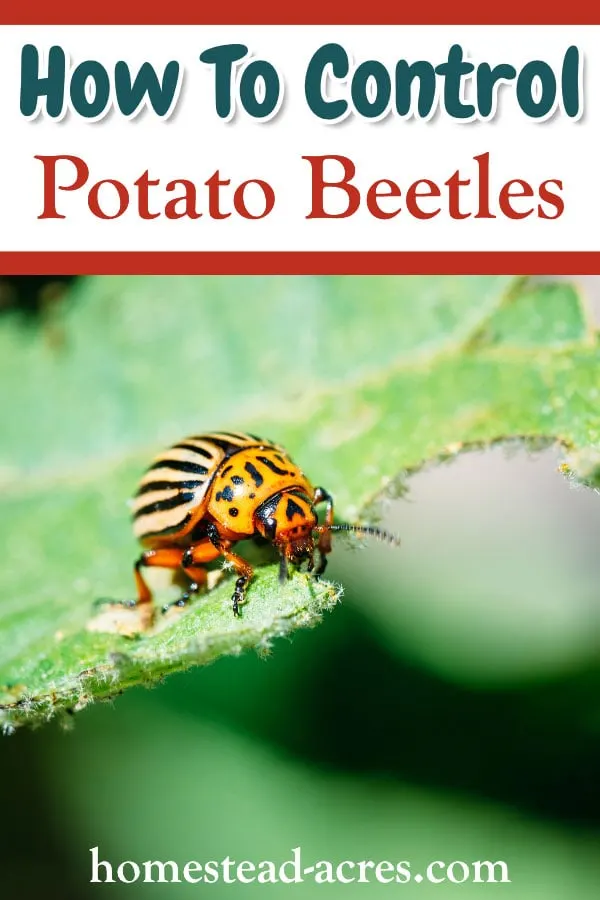

Carol Klein
Monday 7th of August 2023
I have been able to eradicate potato beetles from my crop using a shop vac with a dish soap solution in the receptacle. The vacuum did not harm the plants but quite effectively removed and killed both adults and larvae. Just being alert for eggs and squashing them as I vacuumed for adults and larvae.